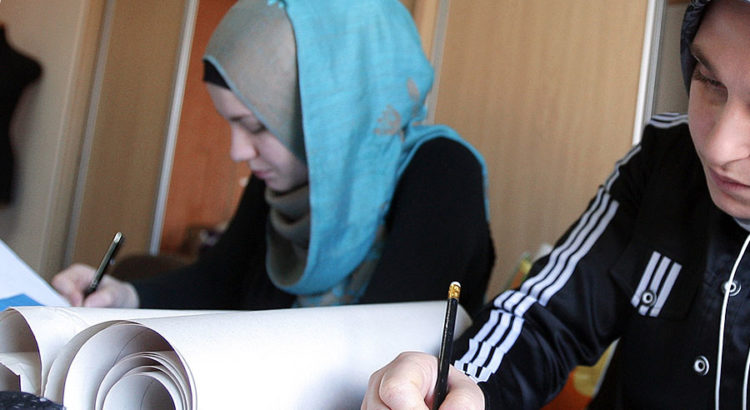Rusia/Febrero de 2017/Fuente: Financial Tribune
RESUMEN: Casi la mitad del público ruso cree que la prohibición del tocado musulmán en las escuelas debe ser levantada, pero una proporción igual dice que las autoridades no deben permitir que los niños demuestren sus alianzas religiosas en las escuelas. Según las últimas investigaciones de la agencia estatal de encuestas VTSIOM, el 47 por ciento de los rusos no ve nada ofensivo en la práctica de las niñas musulmanas usando hijabs en las escuelas (en comparación con el 35 por ciento en 2012). La proporción de aquellos que declararon que cualquier manifestación externa de pertenencia a alguna religión en la escuela debe ser restringida también fue 47 por ciento (menos del 53 por ciento en 2012). El seis por ciento dijo que no podrían elegir los lados en esta discusión en 2017, la mitad de los que lo dijeron en 2012. La proporción de los que se oponían a la prohibición del hijab era previsiblemente más alta entre los musulmanes, pero también entre los jóvenes (18-24 años). La opinión opuesta fue compartida por la gente sobre 45 años vieja y los que se describieron como ateos.
According to the latest research by the state-run VTSIOM polling agency, 47 percent of Russians currently see nothing offensive in the practice of Muslim girls wearing hijabs in schools (compared to 35 percent in 2012). The proportion of those who said any external manifestations of belonging to any religion in schools must be restricted was also 47 percent (down from 53 percent in 2012). Six percent said they could not choose sides in this discussion in 2017, half the number who said so in 2012.
The share of those who opposed the hijab ban was predictably higher among Muslims , but also among younger people (18-24 years). The opposite opinion was shared by people over 45 years old and those who described themselves as atheists.
The head of VTSIOM’s department for special programs, Elena Mikhailova wrote that the main factor causing the cautious attitude towards different religious and social groups was the fact that vast majority of the population was poorly informed about these groups.
About a week ago Russian Education Minister Olga Vasiliyeva voiced support to the ban on hijabs in schools imposed by the Supreme Court ruling in February 2015.
“I don’t think that true believers try to emphasize their belonging to certain religions by external attributes,” the minister said.
The head of the Chechen Republic Ramzan Kadyrov voiced disagreement with this position by an Instagram post. He called Vasiliyeva’s statement her own stance and added that his own three daughters wear hijabs in class, all get good marks and would never remove the traditional Muslim headwear no matter what.
In February 2015, Russia’s Supreme Court ruled to uphold the ban of Muslim headwear in schools, which had been introduced by authorities in the Republic of Mordovia. It rejected a complaint lodged by the Mordovian Muslim community, which claimed that the ban on religious headwear in schools violated the constitutional principle of freedom of conscience. The judge ruled that the ban on wearing headscarves in schools did not prevent Muslims from believing in God and did not infringe anyone’s constitutional rights.
President Vladimir Putin expressed his position on the issue of hijabs in 2012, when he opposed them being worn in schools. He said although people’s religious feelings must be respected, Russia is a secular state.
“We should see how our neighbors, European states deal with [wearing hijabs]. And everything will become clear,” Putin said.
Fuente: https://www.rt.com/politics/375757-russian-society-split-into-equal/







 Users Today : 24
Users Today : 24 Total Users : 35460155
Total Users : 35460155 Views Today : 38
Views Today : 38 Total views : 3418821
Total views : 3418821